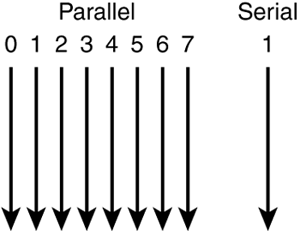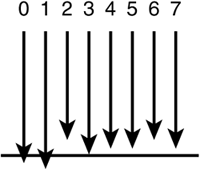Serial Versus Parallel Information Transfer
| < Day Day Up > |
| Information flows through the computer in many ways. The CPU is the central point for most information. When you start a program, the CPU instructs the storage device to load the program into RAM. When you create data and print it, the CPU instructs the printer to output the data. Because of the different types of devices that send and receive information, two major types of data transfers take place within a computer: parallel and serial. These terms are used frequently, but if you're not familiar with the differences between them, check out Figure 3.6. Figure 3.6. Parallel data transfers move data 8 bits at a time, whereas serial data transfers move 1 bit at a time. Parallel Information TransfersParallel transfers use multiple " lanes " for data and programs, and in keeping with the 8 bits = 1 byte nature of computer information, most parallel transfers use multiples of 8. Parallel transfers take place between the following devices:
Why are parallel transfers so popular?
However, parallel transfers also have problems:
As a result of these problems some compromises have had to be included in computer and system design:
Fortunately, there is a second way to transmit information: serial transfers. Serial TransfersA serial transfer uses a single "lane" in the computer for information transfers. This sounds like a recipe for slowdowns, but it all depends on how fast the speed limit is on the "data highway ." The following ports and devices in the computer use serial transfers:
Serial transfers have the following characteristics:
Although RS-232 serial ports are slow, newer types of serial devices are as fast or faster than parallel devices. The extra speed is possible because serial transfers don't have to worry about interference or other problems caused by running so many data lines together. For more information about serial, parallel, USB, and IEEE-1394 ports, see Chapter 8, "Input/Output Devices and Cables." For more information about RAM, see Chapter 7, "RAM." For more information about ATA/IDE, Serial ATA, and SCSI, see Chapter 14, "Storage." |
| < Day Day Up > |
EAN: N/A
Pages: 310

